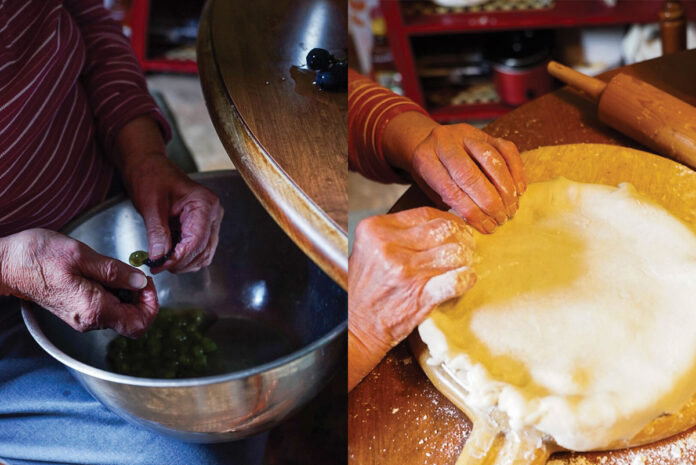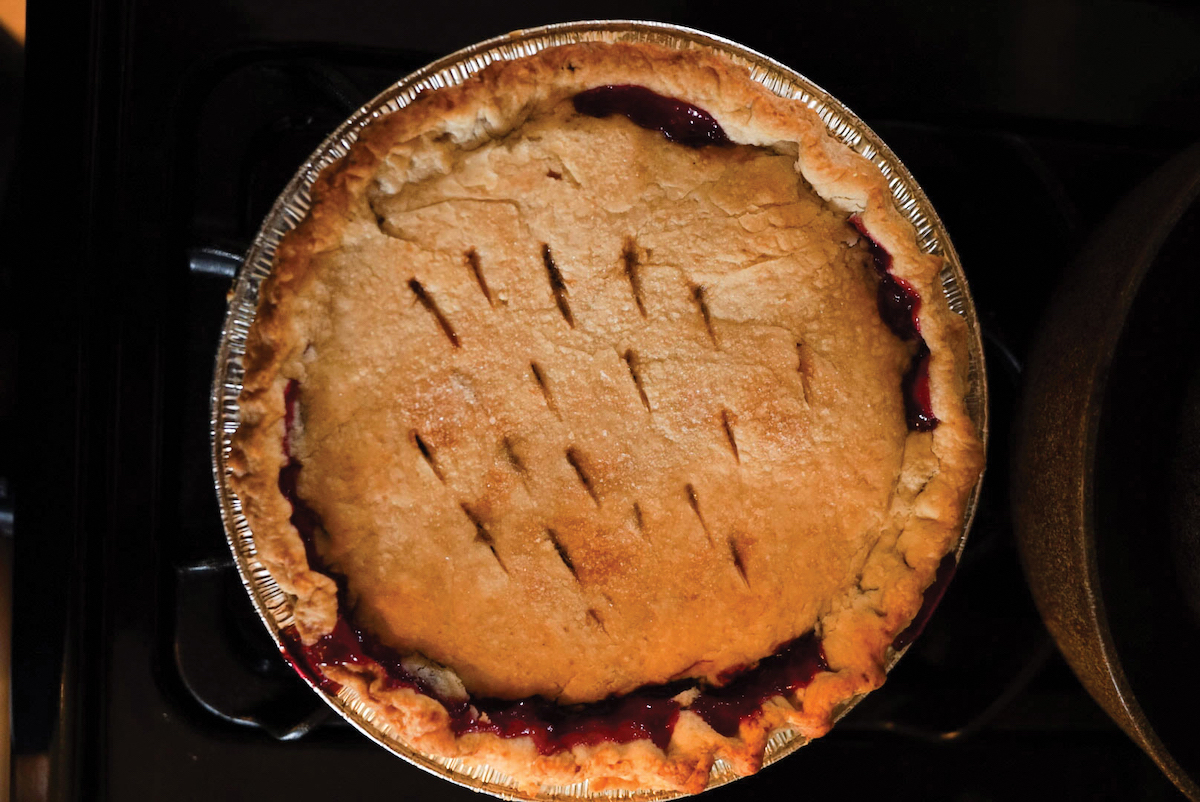
A deep rich purple with a sweet and sour taste, grape pie is an anomaly to many who have never tried or heard of it. Concord grape pie is saturated in misconceptions when it comes to its lack of popularity in the fruit pie category.
Online forums debate this question and claim “There is too much water in them, it makes the crust soggy and gross,” or “It’s a waste of grapes to not use them for wine.”
In reality, grape pie isn’t as common, perhaps, because of the time-consuming process of making one — but the taste is totally worth it.
History of grape pie. Concord grapes were first propagated from wild seeds in Concord, Massachusetts and quickly became popular after the grape won first place in the Boston Horticulture Society Exhibition in 1853.
In the 1870s, concord grapes started to grow in New York. The Finger Lakes region, which makes up Lake Ontario and Lake Erie, is now known as one of the most common Concord grape-growing regions in the county alongside southwestern Michigan and Washington’s Yakima Valley.
Most notably used for Welch’s grape juice, Concord grapes are also commonly used for jams, wine, candy and soft drinks.
The Concord grape pie originates back to the 1950s in the Naples, N.Y region and is credited to longtime Naples resident Irene Bouchard.
The grape pie has since grown in popularity with help from the annual Naples Grape Festival, which sells an estimated 20,000 grape pies every year. The festival also hosts an annual World’s Greatest Grape Pie Contest to prompt healthy competition and a Grape Pie Baking Workshop to educate those interested in learning the art form.
How to make grape pie. My interest in making Concord grape pie stemmed back to a conversation I had with my grandmother a few weeks ago when talking about Concord grapes.
Since I was a little girl, I can vividly remember plucking Concord grapes from my grandparent’s grapevine and popping them into my mouth, savoring their sweet, yet slightly sour taste. Always, the taste reminded me of Welch’s grape juice, even though it really should be the other way around.
During our conversation, my grandmother brought up the old grapevine in her backyard and how she used to make an assortment of products from jam to juice to, above all, grape pie.
Perplexed by the idea of a grape pie, I decided to take a quick trip up to my grandmother’s house to see if the old grapevine still had some grapes left to give.
Doubtful from the lack of upkeep to the vine over the years, I was surprised to find the vine loaded with an abundance of concord grapes — the perfect amount and more to make many grape pies.

Grape pie filling:
2 ½ cups Concord grapes
¾ cups sugar
3 Tbsp. flour
Make sure you have fresh Concord grapes, whether it be from a vine in your backyard or grapes from a farmers market or grocery store. Preheat the oven to 400 degrees.
Concord grapes are known as “slip-skin grapes” because the skin is easily separated from the pulp. It is now that you will be able to put the “slip-skin grapes” into action. Begin by preparing three bowls: one that contains your concord grapes, another bowl for the pulp and another for the skin. Take a concord grape and lightly pinch the skin until it separates from the pulp. Place the skin in one bowl and the pulp in another.
Once all of the skin and pulp are separated, place the pulp in a pot and boil it on low on the stove. Be sure to occasionally stir the pot and watch for the pulp to dissolve into liquid. Once the pulp looks mostly liquid, remove it from heat and set aside.
Since concord grapes have seeds, it is important to remove the seeds before baking them. By boiling the pulp into liquid, the seeds are loosened from the pulp and can now be removed. Grab a strainer and strain the liquid pulp through to remove the seeds.
After removing the seeds from the liquid pulp, mix the skins previously set aside and add them to the liquid pulp. Then add sugar and flour to the mixture.
Prepare your crust according to your favorite recipe and lay the bottom layer of crust in an 8-inch pie pan. Add your grape mixture to the pan and be sure not to fill it too full as grape pie tends to be a rather liquid-based pie.
Then lay your top layer of crust on top of the grape mixture. Cut off excess crust from the sides and indent the sides. Cut slits on the top of the pie to allow airflow. Sprinkle sugar on top if desired.
Place the pie in the oven with a sheet pan below it to catch liquid spillage. After an hour of baking, or when the pie crust is lightly brown on the edges, take the pie out and let it cool.
Set out some plates, dish out a few slices and dig in. For a little extra treat, add some whipped cream and/or vanilla ice cream.
(Reporter Liz Partsch can be reached at epartsch@farmanddairy.com or 330-837-3419.)















Made the pie today. It was great
This article beautifully captures the unique allure of Concord grape pie, shedding light on its history and the process of crafting this delightful treat. The rich, deep flavor of Concord grapes is a true treasure, and it is wonderful to see a traditional recipe like this being shared and celebrated. The step-by-step instructions are incredibly helpful, especially for someone like me who’s never tried making a grape pie before. Your personal connection to the grapevine and memories of plucking fresh grapes add a warm touch to the narrative. I am definitely inspired to give this recipe a try, especially with fresh grapes from the local market.
The article has some inconsistencies. Irene was not the creator. In her autobiography she states she got the recipe from a friend. That friend was Leona Rennoldson. She first sold grape pies roadside in 1941. The Democrat and chronicle has an article and picture in the archives of it. The grape cookie and grape tart were also started by Leona’s eldest daughter Donna Stanton.
Our family is from Nauvoo, I’ll. This is big concord grape pie territory since the late 1840s – early 1850s a little over 100 years before New York thinks they invented it. I was born in 1950 and I know my great grandmother was baking grape pies because that’s who’s recipe I have. I think it was likely a French Icarian thing. They moved into Nauvoo on the heels of the Mormon exodus to salt lake in 1849 and started growing concord grapes. I still make filling for several pies in September. Freezing 4-cup batches for later use. I use 1/4 c of sugar to a cup of grape mixture. Add a table spoon of lemon juice 3T of flour and 1-2 T of tapioca to ensure the pie will set. (I freeze just the grape mixture and the sugar, adding the flour, lemon juice and tapioca to the thawed and heated mixture just before I pour it into the pie shell. Use lard for the pie shell. You only make grape pie once or twice a year so it won’t kill you.) This will produce a set pie without excessive juice. Beautiful color, slightly tart thanks to the lemon juice and not overly sweet pie that will have people craving a second piece. It is extremely rich and intensely “grapey” so 1/3rd sized pieces with vanilla ice cream will make their eyes roll back in their heads with delight.